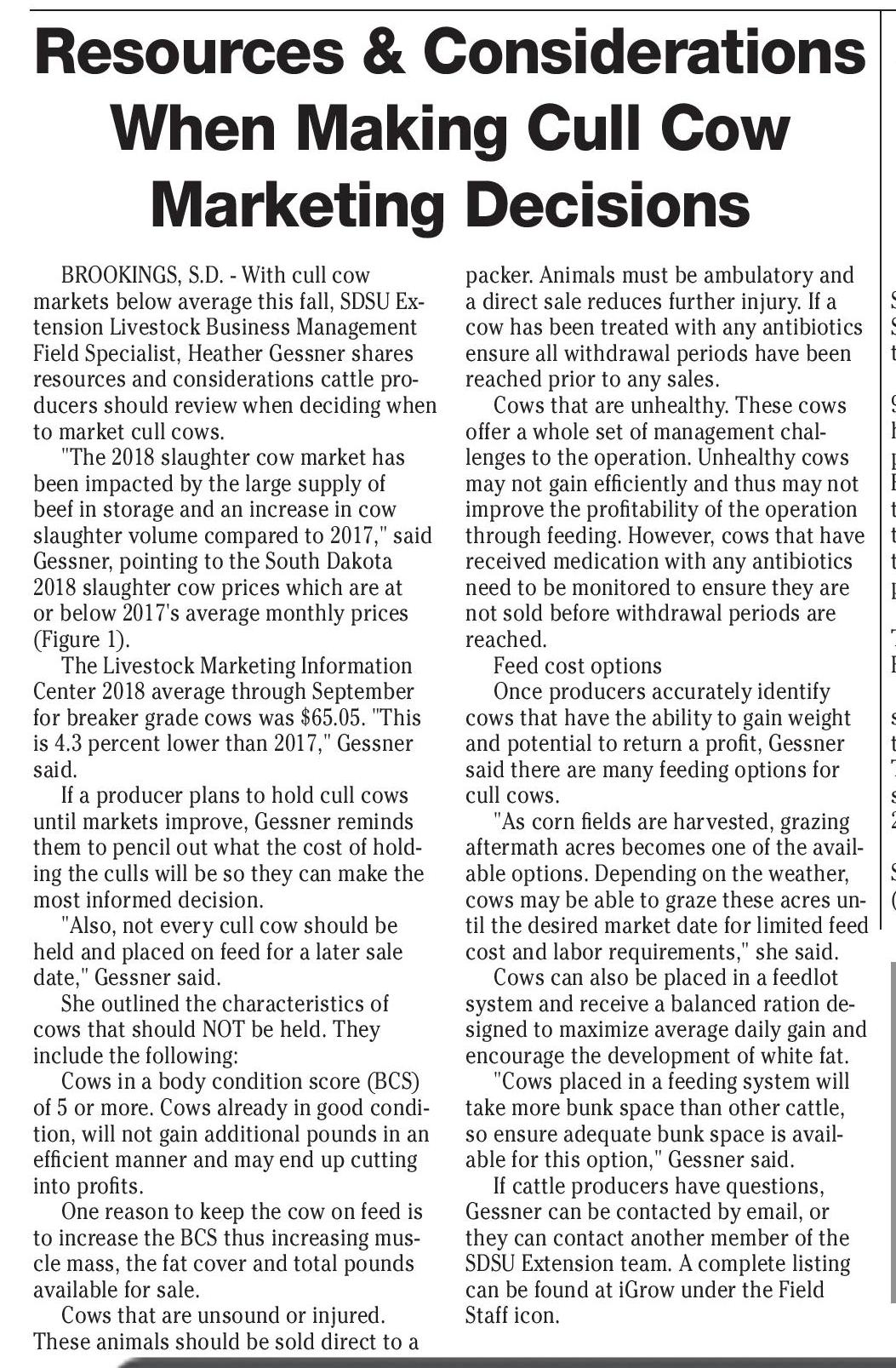103018_YKBP_A11.pdf





Broadcaster Press 11
October 30, 2018 www.broadcasteronline.com
Palmer Amaranth: A Growing Concern In South Dakota
BROOKINGS, S.D. - Although Palmer
Amaranth can be found in South Dakota, it
is currently not wide spread. SDSU Extension staff say it may be possible to limit
the scope and economic burden this weed
could cause if South Dakota producers
and agronomists are vigilant throughout
harvest and into 2019 growing season.
"If producers come across a patch of
Palmer Amaranth in their fields during
harvest, they should consider bypassing
those areas," said Ruth Beck, SDSU Extension Agronomy Field Specialist.
Beck explained that combining mature
Palmer Amaranth or other pigweeds is
not recommended. "However, if combine
harvest cannot be avoided, leaving those
areas till last will help keep from moving
these weeds to other fields or spreading
them further in the field where they are
found," Beck said.
Before leaving the infested area,
harvest equipment should be thoroughly
cleaned.
And, to improve control measures in
2019, Beck encourages producers to make
note of infested areas.
"Those areas will need to be treated
with a strong preplant/preemerge
herbicide program and a follow-up post
emerge application next year," said Paul
O. Johnson, SDSU Extension Weed Science
Coordinator.
Using herbicides with long residuals
and multiple modes of action is recommended.
Field management practices to control
Palmer Amaranth
If Palmer Amaranth is found in a field
this fall, Beck outlined some best management practices to help control the weed.
No-till: Managing infested areas of the
field with no-till will keep seeds on the
surface where they are exposed to weather extremes and predation from birds and
insects. Whereas, shallow tillage favors
germination.
Crop rotation: Crop rotations that
include wheat, corn and milo will give
producers more control options.
Zero tolerance: It is recommended that
producers employ a zero tolerance ap-
proach to controlling this weed.
This may include hand removal of
escapees. "Keeping the field clean until
the crop canopies will help with control
of this weed," Beck said. "Emergence will
drop significantly after crop canopy."
Palmer Amaranth ID tips
Palmer Amaranth was introduced to
South Dakota through seed, equipment,
feed and manure.
It is a versatile weed whose male and
female parts exist on different plants, so,
it needs to cross pollinate to produce
seed, explained Johnson.
"The process of cross pollination
increases the plants genetic diversity and
its ability to develop plant types that are
resistant to herbicides," Johnson said.
A prolific seed producer, Palmer Amaranth has the ability to germinate for an
extended period during the summer, grow
quickly and compete aggressively with
crops for nutrients, light and moisture.
It is difficult to identify Palmer Amaranth from other pigweed species when
the plants are small.
However, Palmer does have some
unique features and these will become
more obvious as the plant ages, said
Gared Shaffer, SDSU Extension Weeds
Field Specialist.
Stem: The stem of Palmer is smooth,
where other pigweeds, such as redroot
pigweed has hairs.
Leaves: Although waterhemp also has
a smooth stem, its leaves usually have a
narrow lanceolate shape versus Palmer
Amaranth which has leaves that are more
diamond shaped or broader across.
Petiole: Another feature unique to
Palmer Amaranth is a long petiole.
Spiny bract: Palmer amaranth can have
a spiny bract where the petiole attaches
to the main stem. This spiny bract is not
common in redroot pigweed or in waterhemp. "Once Palmer Amaranth develops
a seed head it becomes easier to distinguish, as the terminal seed head is usually
very long," Shaffer said.
Resources & Considerations Scholarship Prizes Available
When Making Cull Cow
For Resource Conservation
Marketing Decisions
Speech Contest Winners
BROOKINGS, S.D. - With cull cow
markets below average this fall, SDSU Extension Livestock Business Management
Field Specialist, Heather Gessner shares
resources and considerations cattle producers should review when deciding when
to market cull cows.
"The 2018 slaughter cow market has
been impacted by the large supply of
beef in storage and an increase in cow
slaughter volume compared to 2017," said
Gessner, pointing to the South Dakota
2018 slaughter cow prices which are at
or below 2017's average monthly prices
(Figure 1).
The Livestock Marketing Information
Center 2018 average through September
for breaker grade cows was $65.05. "This
is 4.3 percent lower than 2017," Gessner
said.
If a producer plans to hold cull cows
until markets improve, Gessner reminds
them to pencil out what the cost of holding the culls will be so they can make the
most informed decision.
"Also, not every cull cow should be
held and placed on feed for a later sale
date," Gessner said.
She outlined the characteristics of
cows that should NOT be held. They
include the following:
Cows in a body condition score (BCS)
of 5 or more. Cows already in good condition, will not gain additional pounds in an
efficient manner and may end up cutting
into profits.
One reason to keep the cow on feed is
to increase the BCS thus increasing muscle mass, the fat cover and total pounds
available for sale.
Cows that are unsound or injured.
These animals should be sold direct to a
packer. Animals must be ambulatory and
a direct sale reduces further injury. If a
cow has been treated with any antibiotics
ensure all withdrawal periods have been
reached prior to any sales.
Cows that are unhealthy. These cows
offer a whole set of management challenges to the operation. Unhealthy cows
may not gain efficiently and thus may not
improve the profitability of the operation
through feeding. However, cows that have
received medication with any antibiotics
need to be monitored to ensure they are
not sold before withdrawal periods are
reached.
Feed cost options
Once producers accurately identify
cows that have the ability to gain weight
and potential to return a profit, Gessner
said there are many feeding options for
cull cows.
"As corn fields are harvested, grazing
aftermath acres becomes one of the available options. Depending on the weather,
cows may be able to graze these acres until the desired market date for limited feed
cost and labor requirements," she said.
Cows can also be placed in a feedlot
system and receive a balanced ration designed to maximize average daily gain and
encourage the development of white fat.
"Cows placed in a feeding system will
take more bunk space than other cattle,
so ensure adequate bunk space is available for this option," Gessner said.
If cattle producers have questions,
Gessner can be contacted by email, or
they can contact another member of the
SDSU Extension team. A complete listing
can be found at iGrow under the Field
Staff icon.
PIERRE, S.D. – Contestants in the 2019
State Finals of the Resource Conservation
Speech contest will be eligible to win a
total of $2,300 in college scholarships.
All South Dakota students in grades
9-12 are eligible to compete for $2,300 in
higher education scholarships, which are
provided by East River and Rushmore
Electric Power Cooperatives, as well as
the South Dakota Rural Electric Association. Scholarships are awarded to the top
three finalists: first place is $1,100, second
place is $750 and third place is $450.
The theme for the 2019 contest is “Ag
Technology: Farming & Ranching for a
Future.”
Contests are coordinated by local conservation districts. Local winners advance
to area contests held in seven locations.
The top area speakers compete at the
state finals in Pierre on Saturday, April 27,
2019.
The contest is sponsored by the
South Dakota Department of Agriculture
(SDDA), in cooperation with Touchstone
Home of Great Ideas
since 1934
201 W Cherry St. • Vermillion, SD
Phone: 624-4429 • Fax: 624-2696
BroadcasterOnline.com
ACREAGE AUCTION
Reuse.
Repurpose.
Really Save!
Take a fresh look at the
Classifieds, the original
way to shop green!
9.36+ Acres • HISTORIC HOME • Clay County, South Dakota
Tuesday,
November 6, 2018
Amazing Opportunity to Purchase
a Rewarding “Fixer-Upper”!
at 12:00 Noon
On Site
3103 East Main Street
Vermillion, South Dakota
Broker Participation Offered
• Two tracts with a great location just
outside of Vermillion
• 2.26+ acres with large, historic home in
need of repair
•7.10+ acres offering a great opportunity to
build a home close to town with room for barn, horses,
and large garden
L-1800798
For additional information details, please contact:
Marshall Hansen, Agent/Auctioneer • Salem, South Dakota
Business: (605) 360-7922
MHansen@FarmersNational.com •www.FarmersNational.com/MarshallHansen
bp
Since 1934
Paul Sickler, AFM/Agent • Brandon, South Dakota
Business: (605) 582-2085 • Cell: (605) 366-4704
Broadcaster Press
201 W Cherry
Vermillion
624-4429
bp roadcaster
Since 1934
B
Press
PSickler@FarmersNational.com •www.FarmersNational.com/PaulSickler
www.FarmersNational.com
Real Estate Sales • Auctions • Farm and Ranch Management
Appraisal • Insurance • Consultation • Oil and Gas Management
Forest Resource Management • National Hunting Leases • FNC Ag Stock
Energy Cooperatives of South Dakota,
the U.S. Fish & Wildlife Service and the
South Dakota Association of Conservation
Districts.
For more information on the Resource
Conservation Speech Contest, contact
your local conservation district or call Tiffany Thompson, natural resource specialist for SDDA, at 605.773.3623.
An entry form and complete list of
rules can be found online at: http://sdda.
sd.gov/conservation-forestry/educationalprograms/resource-conservation-speechcontest/PDF/2019Speech-Brochure.pdf
Agriculture is a major contributor to
South Dakota’s economy, generating $25.6
billion in annual economic activity and
employing over 115,000 South Dakotans.
The South Dakota Department of Agriculture's mission is to promote, protect
and preserve South Dakota agriculture
for today and tomorrow. Visit us online at
http://sdda.sd.gov or find us on Facebook,
Instagram and Twitter.




















 Previous Page
Previous Page






